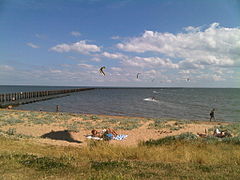Shoeburyness
| Shoeburyness | |
|---|---|
 Shoebury East Beach |
|
| Shoeburyness shown within Essex | |
| Population | 11,159 (2011 Census |
| OS grid reference | TQ941851 |
| Unitary authority | |
| Ceremonial county | |
| Region | |
| Country | England |
| Sovereign state | United Kingdom |
| Post town | SOUTHEND-ON-SEA |
| Postcode district | SS3 |
| Dialling code | 01702 |
| Police | Essex |
| Fire | Essex |
| Ambulance | East of England |
| EU Parliament | East of England |
| UK Parliament | |
Shoeburyness (also called "Shoebury") is a town in southeast Essex, England, at the mouth of the Thames Estuary. It is within the borough of Southend-on-Sea, situated at its far east, around 3 miles (5 km) east of Southend town centre. It was an urban district of Essex from 1894 to 1933, when it became part of the county borough of Southend-on-Sea. It was once a garrison town and still acts as host to MoD Shoeburyness.
The eastern terminus of the London, Tilbury and Southend Railway (c2c line) is at Shoeburyness railway station, services run to London Fenchurch Street in the city of London. The eastern end of the A13 is at Shoeburyness. The MoD Shoeburyness site at Pig's Bay is situated nearby and the facility is run by the company QinetiQ.
Shoeburyness has two beaches: East Beach and Shoebury Common Beach (also known as West Beach), both Blue Flag beaches.
East Beach is a sandy/pebbly beach around a quarter of a mile long and is sandwiched between the Pig's Bay MoD site and the former Shoeburyness Artillery barracks. Access to the large gravel/grass pay-and-display car park is via Rampart Terrace. East Beach is the site of a defence boom, built in 1944, to prevent enemy shipping and submarines from accessing the River Thames. This replaced an earlier, similar boom built 100 yards (91 m) east. The majority of the boom was dismantled after the war, but around one mile still remains, stretching out into the Thames Estuary. East Beach benefits from a large grassy area immediately adjacent to the sands, which is suitable for informal sports and family fun.
Shoeburyness is where, during the Second World War, a magnetic ground mine, which was deposited in the mud at the mouth of the Thames by the Luftwaffe, was discovered by the MOD. Up until that time, various sinkings of ships around the English coast were thought to be due to U-Boat torpedoes. The discovery of the ground mine allowed countermeasures to be introduced to neutralise the weapon's effect; one of these was the degaussing cables installed in merchant ships in allied and British fleets, and of course the wooden minesweepers.
...
Wikipedia

